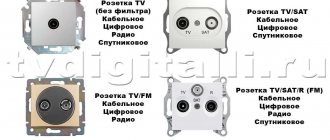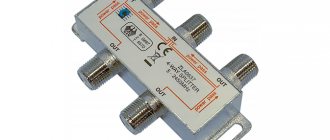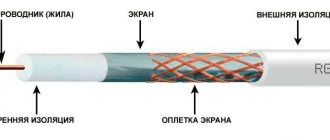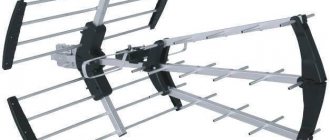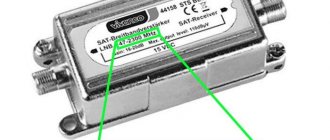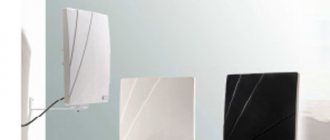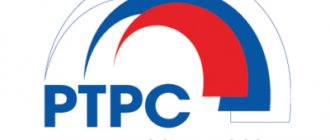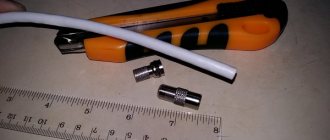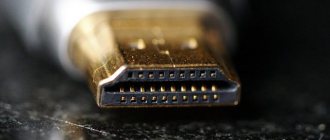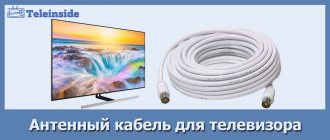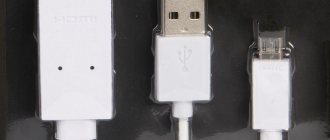The quality of digital television broadcasting directly depends on the cable used. Sometimes, due to a cable with a high level of signal attenuation, a person cannot watch his favorite TV shows normally. The stores offer dozens of models of cables of different cross-sections, dielectric quality, conductor composition and shielding layer. How to choose an antenna cable for digital television so that everything works like a charm? Let's discuss the best brands of television cables. If you are not interested in theory, but need to quickly select a cable, click here.
Antenna efficiency
The antenna will work without an amplifier.
Signal reception is ensured due to the design of the receiver. The form is designed in such a way that you can set up digital TV channels on your TV.
The design is primitive, so to receive an over-the-air signal you need:
- so that the power of the incoming signal to the antenna is at a high level:
- the repeater must be located near your current location;
- there should be no obstacles on the signal path (tall buildings, hills, etc.);
- so that the signal is present at all. There are areas where the digital terrestrial television signal does not arrive at all. Then, no matter what the antenna is, it will not be possible to tune the channels on the TV receiver.
Required materials and tools
- Coaxial cable with a resistance of 75 ohms. The cable length is not that important. But it is better to choose the shortest possible cable, since with every meter the signal attenuates. As a result, the TV receives less signal and may have problems displaying channels. There may be freezes, “No signal” messages, or the appearance of squares.
- Use a utility knife or other cutting tool to strip certain parts of the cable.
- Pen or marker for marking cables. The parts that need to be stripped of cable insulation will be marked.
- RF connector with adapter (plugs) to insert the cable into the antenna connector of the TV.
- Pliers. The tool is optional, but will help make the contact more tightly at the last antenna connection.
- Wood (plywood). After manufacturing, the antenna needs to be shaped into a ring (loop). The cable is subject to change in shape due to natural reasons. Therefore, it is better to fix the loop on a wooden frame so that the shape remains unchanged even under the influence of external factors (strong wind).
Throttle filter
We recommend equipping each end of the extension cord connecting the TV and the splitter with a choke filter (a ferrite ring that fits onto the cable). This simple solution will significantly reduce interference. It is also advisable to place the splitter in a special panel.
We are confident that our advice will help you correctly connect any device, from a TV, tuner, modem (video signal modulator into an antenna cable) to a satellite dish. In the latter case, you will need a receiver, for example, if you want to purchase the Tricolor TV package.
If you doubt your abilities or don’t want to waste time, you can always invite specialists who will help you stretch the television wire into the apartment and lay it through it (do the wiring).
To receive a TV signal, the antenna and the TV (set-top box) must be connected by cable. At the same time, how good the playback of TV programs will be largely depends on the quality of the wire. Let's figure out how the antenna cable for digital television works, which brands are better to choose so as not to overpay.
Making a “loop” with your own hands
The manufacturing process consists of several stages:
- cable marking (marks are made at exact distances so that stripping can be done later);
- short circuit of the antenna cable at the end stripping point;
- Installing an antenna plug to connect the cable to the antenna input of the TV.
How to mark the cable
- From any free end of the cable, the first mark is made after 5 cm.
- Then another 22 cm is measured and a 2 cm section is marked.
- Then a centimeter section is again marked at a distance of 22 cm from the last mark.
Marking scheme
Proper stripping
- The first 5 centimeters of the cable are completely cleared of insulation. Both the external insulation and the internal one, which protects the core, are removed. A connection (twisting) of the shielding layer with the core is made.
1
2
3 - In the second section, the outer insulating layer along with the shielding layer is removed.
It is important to be careful not to damage the internal insulation. In the future, damage to the insulation may cause the inner core to break.
- In the third section, only the top insulation is removed, the screen is not touched.
Next, the first stripped section is screwed onto the last one. Twisting is done by hand. Additionally, you can use pliers to press the contact.
Afterwards we try to give the shape of the loop as accurately as possible.
By the way, the antenna was called “loop” because of its shape.
RF Connector Installation
The cable is connected to the antenna connector of the TV receiver through an adapter. It, in turn, is screwed into the RF connector. The latter must be correctly placed on the other end of the cable.
- Remove the top layer approximately 1 cm long.
- We bend the foil layer and copper braid back onto the cable itself.
- The internal insulation is removed. You can remove it completely by the same 1 cm, but it is better to leave at least 2-3 mm to prevent the screen from shorting to the cable core.
- Screw the connector onto the cable. If it is difficult to do this with your hands, you can carefully clamp the connector with pliers and screw it on. Be careful, as modern connectors are made of brittle metals. There is a high risk of the metal cracking. You'll have to buy a new connector.
- The connector must be inserted so far that the cable core is fully visible (refer to the figure below).
- An adapter is screwed into the connector using a thread. It will be inserted into the antenna input on the television receiver.
Coaxial cable design
Although coaxial cable may differ in conductor material and insulation quality, all types have approximately the same design:
- PVC insulation . It is resistant to ultraviolet radiation and protects the shielding layer and conductor from mechanical stress. May be black or white. Previously, black cable was intended for installation outside the window, and white cable inside the house. However, now manufacturers have moved away from such markings and now the insulation of almost every cable of any color can withstand environmental factors.
- Braided screen . The braid can be made of aluminum or copper wires. The thickness of each wire usually does not exceed 0.12 - 0.16 mm2.
- Foil screen . Along with the braiding, it protects the signal passing inside the wire from external interference. It can be single or double.
- Polyurethane dielectric.
- Conductor . The conductor can be made of pure copper or copper-plated steel. The first is more expensive and is usually used for satellite TV (although it is also suitable for others), while the second is cheaper and can be used for digital and terrestrial television broadcasting.
Frame manufacturing
If the antenna will be installed outside the building (on the street), then you need to build a frame. It will maintain its loop shape even when the antenna is exposed to strong winds.
You can make a frame by cutting out a ring in a similar shape to the antenna from plywood or any other material. The cable is then secured to the ring with electrical tape, tape or clamps.
You can also attach a mast - a long stick - to the frame to secure it on the street.
Setting up TV channels
After the coaxial cable antenna is made, installed and connected to the TV, you can start setting up digital television.
Settings are performed differently on different brands of TVs. But the principle of searching for channels is the same everywhere. You need to go to the channel settings menu and perform an automatic or manual search.
Before setting up, be sure to go to the manual setup item and look at the signal level scale. If the signal is weak, try playing with the antenna, placing it in a different place, raising it higher, or changing the direction.
Example of a scale on a Samsung TV
For the most accurate direction of the structure to the nearest TV tower, use the terrestrial digital television map (karta.rtrs.rf). Enter your area and house number in the search bar. Click on your home and a table of repeater characteristics will appear. Look at the compass icon. When directing, be guided by it. This way you can receive the signal most accurately.
In most cases, automatic tuning of air channels will help. If the antenna shows only 10 channels out of 20, this may indicate the following:
- There is only one multiplex broadcasting in your area. This means you can only watch 10 channels.
- The signal is very weak, so only one of the channel packages (multiplexes) is caught. In this case, a more powerful antenna will help. Some options you can do yourself. But it’s better to take a closer look at factory antennas with a built-in amplifier.
After auto-search, if not all channels are shown, try searching manually. Then you need to find out the TVC (television channel) numbers or multiplex frequencies. All data is taken from the ECTV card.
Next, search for each multiplex one by one.
Kinds
Let's briefly look at the types of products.
Coaxial cable
This type of conductor is the most common of those used to install television networks. Any TV has an output for connecting a wire. One of the features of the conductor is the low quality of the characteristics. The use of coaxial cables is important for connecting home antennas to TV devices. By design, in such products the components of the electromagnetic field are always installed between the conductors; they are isolated relative to each other. Thanks to this, the design provides maximum protection from external interference and helps reduce the likelihood of field loss due to radiation.
In coaxial television cables, impulse transmission is always carried out through the internal conductor.
Chipdip channel. provided a detailed overview of coaxial cable and talked about wire selection.
Composite cable
The composite type product structurally includes three conductors. One of them is designed for transmitting video signals, and the other two are for stereo pulses. Composite cables are used to connect various video devices to a TV or monitor. The wire type allows only analog pulses to be transmitted. Connect the cable to the equipment taking into account the colors of the conductor and plugs.
Component cable
Component products belong to the category of first generation conductors. If you need a cable that can efficiently transmit digital impulses for satellite television, then the component option will be the most optimal. Structurally, it consists of three cords, each of which transmits video signals. Regardless of the manufacturer, the package of such wires must include a special kit for connecting audio tracks. The procedure for connecting the conductor to the TV is carried out taking into account the colors.
HDMI, DVI cables
This type of wire should be used to transmit high quality video pulses. If the TV is equipped with an HDMI output, it is recommended to connect the cable to this connector to ensure the highest quality contact. As for DVI products, they are used to transmit video signals, while audio tracks are not used as a conductor; an HDMI output is intended for them. This type of cable is widely used in computer technology; it is used to connect game consoles and other similar equipment.
Alexey Vinogradov spoke about connecting an HDMI cable to a TV.
